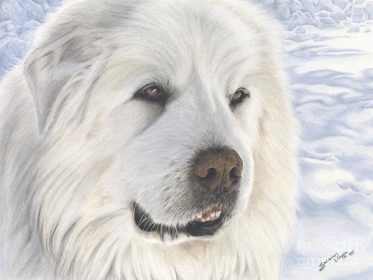
Between avalanches and an outbreak of distemper, the number of Saint Bernards was seriously depleted at the hospice in Switzerland. In 1870, several large breeds were used to help the Saint Bernard back to recovery, and one of those breeds was the Great Pyrenees. Fifteen years later, the first registrations of Great Pyrenees with England’s Kennel Club occurred along with the first exhibition of the breed at the Crystal Palace dog show.
Image: Tribute To Pyreless, the Great Pyrenees Mountain Dog” by Sheldene Visagie is available as a print, poster, pillow and more here

Is there a good reference on how breeds can be pulled from the brink of extinction? What is the process when you introduce another breed? If there are only a few dogs from breed left are you able to build the population and ensure a certain amount of genetic diversity? Can it be done if you only have 1 dog and 2 bitches of a breed without introducing another breed?
You ask great questions, Sue, and we wish we were the voice of authority on answering them, but we would direct you, instead, to the parent club of the impacted breed, and the AKC. There has to be a compelling reason to introduce the bloodlines of one breed to another, such as was done with the Backcross Project involving the Pointer and the Dalmatian to deal with a gene that predisposed Dals to unique uric acid calculi and urinary blockages (read about this here: http://www.dalmatianheritage.com/about/nash_research.htm). More was written about it by our colleague, Caroline Coile, PhD at http://www.carolinecoile.com/blog/spots-stones-pointers-and-dals-and-the-akc. If you reach a dead end, let us know?